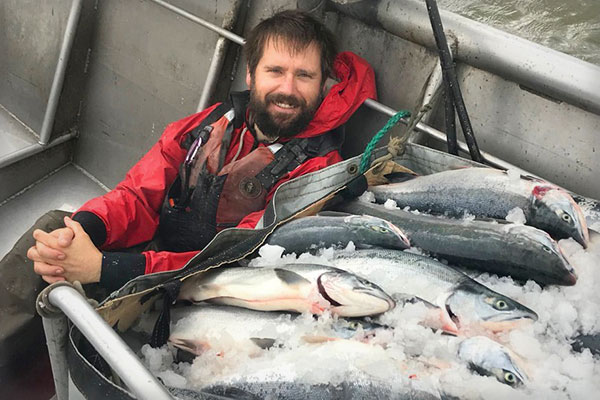Even if you don’t eat a lot of fish, chances are you know what salmon looks like. But what should it look like? We all know the distinctive pink fish, but many people don’t know there’s a vast difference between farm raised (and dyed) salmon you find in the grocery store and wild-caught Alaskan salmon.
The difference is so big, I wrote a whole blog on it here.
What I didn’t know, however, was the wide range in quality you can find in “fisherman-direct” businesses that sell wild caught Alaskan salmon to consumers all over the globe. To get the truth about the world’s most popular fish, I spoke to Traveler Terpening, the owner of Salmon & Sable.
“I started commercial fishing when I was 15 years old,” explains Traveler. Growing up in Alaska, he was raised to respect and honor his catches. “We have sustainable fisheries written in our constitution, we take it seriously.”
This commitment to sustainable fisheries means that Alaskan commercial fishing permits are hard-won and respected. Traveler gets his catch from the Ugashik River in Bristol Bay, a place so remote it’s thought of as the Wild West. There are no roads in or out of the fishing grounds, just miles of beautiful shoreline and rivers jumping with the best quality salmon in the world.
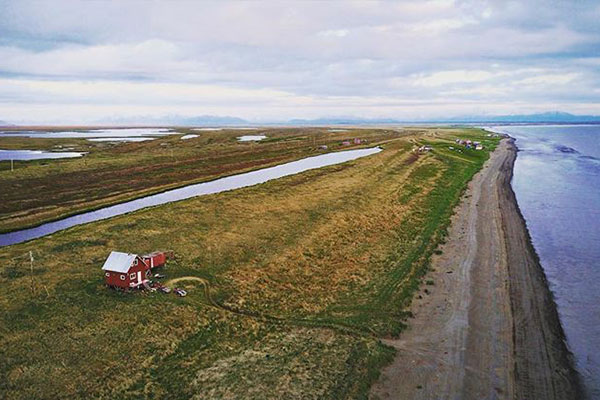
Traveler not only catches wild Alaskan salmon, he also fillets them and pulls the pin bones personally. Then he flash freezes onsite and ships his catch directly to his buyers.
Think your fisherman direct source is doing that? You may want to check.
The Truth of “Fisherman Direct”
If you’ve spent the time and energy finding a Fisherman Direct business, you’re probably assuming that you’re buying today’s catch directly from a boat. Usually, that’s not the case.
Because processing fish is an expensive and heavily regulated process, most fishermen can’t afford to do it. Instead, they sell their catches to canneries or processing plants that use inexpensive labor or machines to fillet, bone and package the fish. These corporate companies can process huge quantities of fish in a short amount of time. Then, the fishermen buy other bulk processed and packaged fish and sell it to consumers.
That’s hardly the fresh-from-the-boat quality most customers think they’re paying for.
The problem, explains Traveler, is there’s no way to tell who caught what using this corporate processing model. “You’re not getting a better product. Often you’re getting anonymous mediocre quality fish bought from fishermen.”
It’s the most cost-effective way to run a business and when Traveler started out, it was his business model too. He didn’t like that business model, but he admits it was a successful one, and a good place to learn about what was missing.
“Customers never asked me did you catch this fish with your own hands? Because if you’re a fisherman selling fish, that’s what they assume. It gave me an insight into how disconnected people are from their food.”
Reestablishing the Connection
The disconnect between people and the fish they were buying didn’t sit well with Traveler.
“You have all these beautiful creatures out there and they make beautiful food. Each one needs to be treated with respect and reverence,” says Traveler. “Commercial fishing doesn’t have that reverence sometimes.”
Traveler decided to bring reverence back to the dinner table. He made a commitment to give customers the quality product they should expect from a fisherman direct business. “I wanted to catch less and treat every single fish like the special food and creature that it is.”
To do that, he had to build his own processing system. Salmon & Sable fish don’t ever see a factory. There are no roads from where Traveler fishes in Bristol Bay to any processing plant anyway. So everything is done on one strip of beach. Traveler walks the fish directly from the boat to his filleting cabin and then brings them to the walk-in freezer he built himself.
“Either my crew or myself catch every fish and I personally filet every single salmon that goes to my customers.”
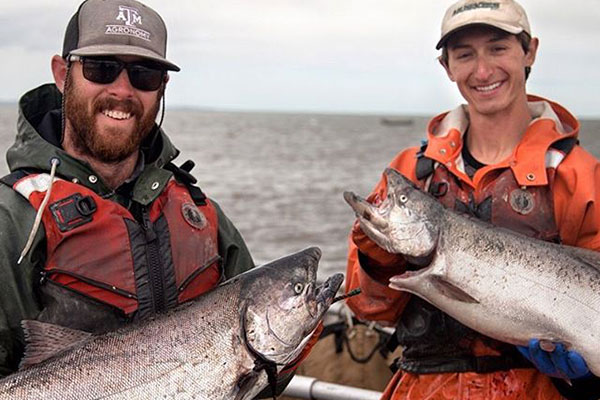
That personal work shows with the quality of the protein Salmon & Sable offers. Disappointed with the tell-tale trenches in most commercially sold salmon fillets–where machines remove pin bones along with chunks of your fish–he spent tens of thousands of dollars on a Danish analog bone remover. But there was still a trench on his fillets.
“All pin bone-free fish has this trench dug down it from machines,” says Traveler. “But if you do it by hand, like I do, the fish looks perfect.”
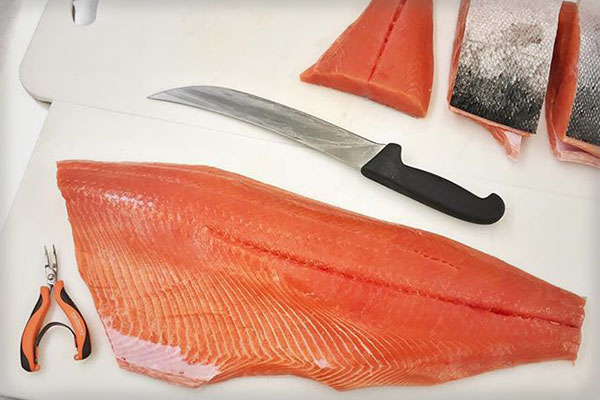
Aesthetics are important to Traveler, who has a Bachelors Degree in fine art. It’s important to him that his customers appreciate the fish he sells as much as he does. There’s even a section of the Salmon & Sable website dedicated to teaching you about the different cuts and types of fish. Traveler believes an informed consumer will demand a better product. “I turn out the highest quality that is humanly possible.”
That means, you won’t find temperature abuse (which causes gapping in the meat) or any pin bone trenches on any fillet he sends you. If you buy a fish from Salmon & Sable, you can rest assured it’s been in Traveler’s care since it came out of the water.
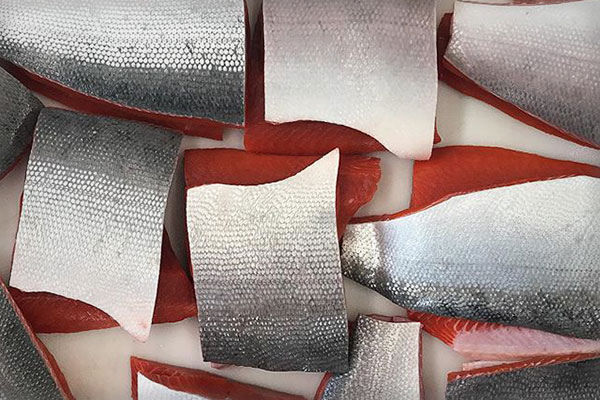
Joining the Crew
Traveler likes to think of his customers as partners in better eating; that’s why he offers them “shares of the catch” instead of just selling fish. Instead of ordering a single fillet, customers buy a share of Traveler’s catch–that’s 10 lbs. of the best quality wild caught Alaskan salmon in the world.
Ten pounds might sound like a lot, but he promises you can fit that in your freezer. “Some customers are ordering hundreds of pounds at a time.”
Because of the hand-processing and blast freezing, you can fill order a year’s worth of fish from Salmon & Sable and never have to worry about it going bad. “It’s blast frozen and a high fat fish–it will last in your freezer for 12 months. It will taste just as beautiful no matter when you thaw and cook it.”
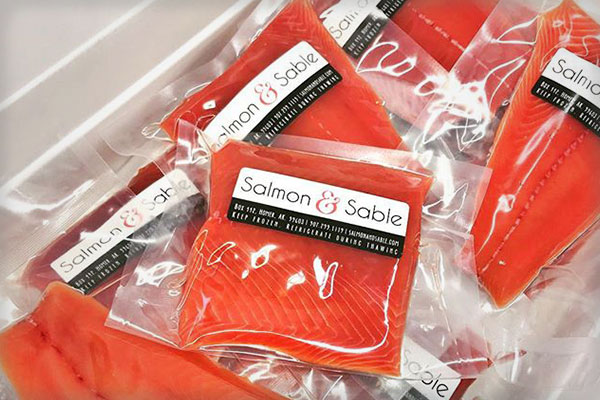
Salmon & Sable ships four times a year, and ordering for the 2019 Winter Share opened on February 1st. You can order from the winter share, which ships in March; the spring catch, which ships in May; the summer catch, which ships in October; or the Christmas catch, which ships in December.
Fans of this rare quality craft protein understand that quality takes time. It’s not the instant gratification of ordering on Amazon or running to your grocery store.
“(With) high-end foods that are done by hand for you, you can’t just get whatever you want whenever you want” He explains. “If you want really beautiful high-end food caught and personally handled for you, you have to be willing to wait.”
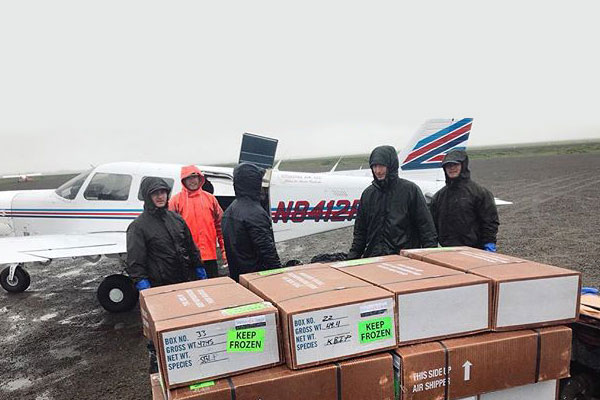
For those new to the world of salmon, Traveler is running a special to help you learn about your tastes. This year, Salmon & Sable will offer a sampler share–featuring 3 lbs. of Coho Salmon, 3 lbs. of King Salmon, and 3 lbs of Sockeye Salmon. It’s the perfect way to introduce you or your family to the best fish Alaska can offer.
Honoring the Catch
As you might expect, Traveler eats a lot of salmon. So, I asked him for his opinions on the best ways to cook his salmon fillets.
“I’ve become more open minded about ways to cook fish, because I eat so much salmon. But the purist in me–who just wants to revere the food–says that you just grill it all with salt and pepper and some olive oil. Grilling is really an incredible way to go; it taps into some of the beauty of smoked salmon.” The skin serves as a built-in cook plate and an extra crispy treat.
He’s right, though I might suggest a bit of Roasted Garlic and Dill Butter on top.
Traveler has so much experience cooking salmon, he’s even developing a recipes section on his website. Until then, be sure to grab some of the best quality fish in the world from Salmon & Sable and check back here for new recipes featuring one of my favorite ingredients.


